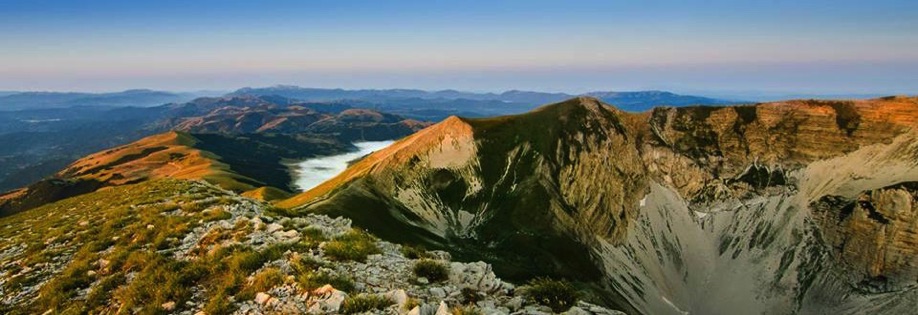
{photo taken on top of Monte Vettore, by courtesy of Fabio Pergolesi}
THE MOUNTAINS
The Monti Sibillini National Park, formed in 1993, encompasses 714 sq kilometres of some of the most diverse and spectacular landscape in Europe. The Park offers a level of pure, undisturbed nature and privacy that is rarely experienced in Europe. Simultaniously this is a classic 'cultural landscape', inhabited from 4000 B.C. and still abounding in rich traditions and ledgends today.
For walking routes and a more detailed look at the fascinating history of this mountainous region, we recommend the book "Walking in the Sibillini, History and Recipes Celebrating a Distinctive Mountain Culture”, which is on sale in Park Visitor Centres and offers a portrait of the food and distinctive culture of the mountains from prehistoric times.
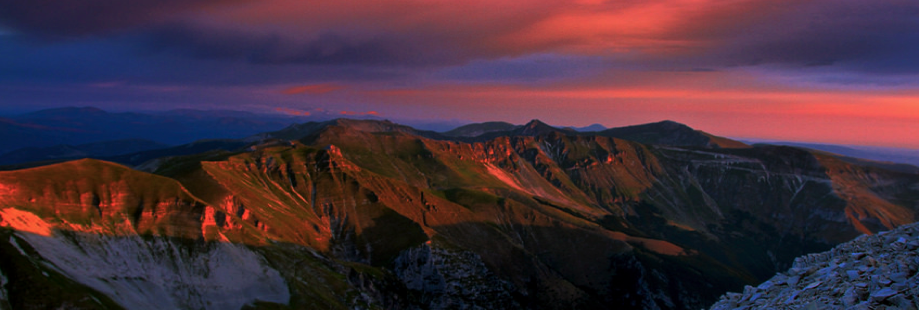
{photo taken by Roberto Perucci , by courtesy of sibilliniweb.it}
Magic! The Sibyl did not practice witchcraft, rather she predicted the future and reclaimed knowledge from the past. She lived in a cave near the summit of Mount Sibilla and since time immemorial she shaped the culture and in the imagination of the people of the Monti Sibillini, firstly as a pagan symbol of fertility, venerated within the tradition of earth worshiping, and then later she also became part of Christian iconography, which is evidenced by numerous paintings in some local churches. The 'Apennine Sibyl' is a controversial figure, whose fame as a witch and heretic enchantress was actually renowned in many parts of Europe in the fifteenth century, and the name of these mountains is a tribute to her importance.
In front of her cave opens the beautiful valley of 'Lago di Pilato', and legend relates that this lake is the tomb or resting place of the Roman consul who condemned Jesus Christ to death. Both Monte Sibilla and Lago di Pilato were frequented for centuries by necromancers, esoterics and by mysterious people. Throughout history these two sites repeatedly attracted the attention of the Pope who sought to physically prevent access to these locations in order to repress what was perceived as dangerous tendencies. There are reports that entire villages in the Sibillini, like that of Montemonaco, were excommunicated. Pitchforks were placed on the high altitude mountain routes as a warning to travellers.
Certainly some people came with the intention of consecrating their magic books to the devil, but perhaps others were harmless herbalists who at the time were already fascinated by the biodiversity of these mountains.
Indeed, diversity of landscape and biodiversity are key to this special place: from the north, the Monti Sibillini are the first mountain range in the central Apennines to be characterized by glacial valleys, deep gorges, vast mountain meadows, rocky cliffs and more than twenty peaks over two thousand meters. The mountains are located slightly to the east of the 'spine' between Umbria and the Marche, and they offer a privileged position from which one's gaze embraces Tuscany, Lazio, past all the mountains of Abruzzo, and the Adriatic sea, where on clear days the Dalmatian coast is visible. This mountain chain is predominantly limestone and the presence of karst phenomena has shaped the landscape resulting in sinkholes and dolines. This highly panoramic position has immense strategic importance for biodiversity because it straddles three different biomes; Balkan, Mediterranean and Alpine. These habitats guard nearly 2000 species of flora and over 200 species of vertebrates.
In the high altitude environments the peaks are snow covered during the cold months and in the spring they create a carpet of beautiful and fragrant flowers among which are the Apennine edelweiss, genzianas, anemones, and rock poppies.
In these environments live the Apennine chamois, the eagle, and the rock partridge. Historic Alpine animals flourish here once again today such as the Alpine finch, the snow vole and the chirocefalo Marchesoni that is only found in the waters of Lago di Pilato – the single relation to this small crustacean lives in the Himalayas.
Descending to a lower altitude, there are forests and secondary grasslands where nature conjoins with the presence of man offering a home to many species of flora like orchids, daffodils, peonies, lilies, tulips, as well as fauna like the wild cat, buck, roe deer and wolf.
The union of man and nature finds its highest expression within the flowering plains of Castelluccio. These plains are part of a beautiful, vast plateau enclosed by mountains, where the highest point of habitation in the Apennines is located. In June and July the surrounding fields are planted with farro, lentils and other legumes and they create a tapestry of wild flowers of incredible colours: mustard, cornflowers and poppies, creating one of the images the Park is most famous for.
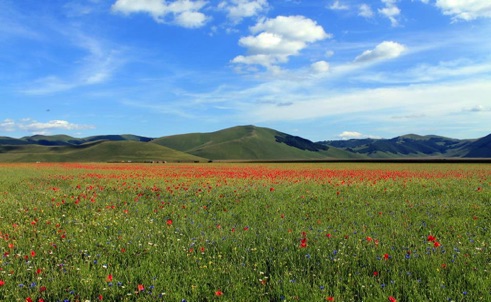
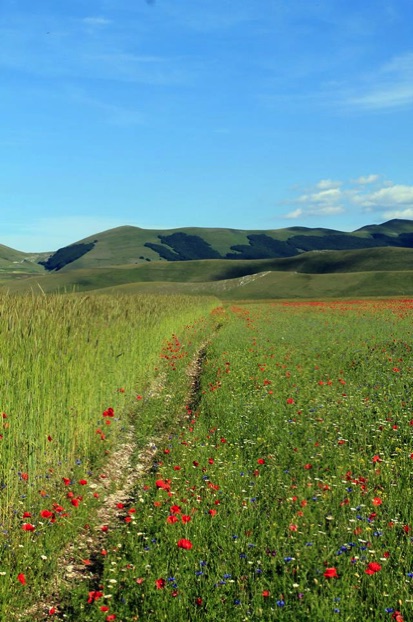
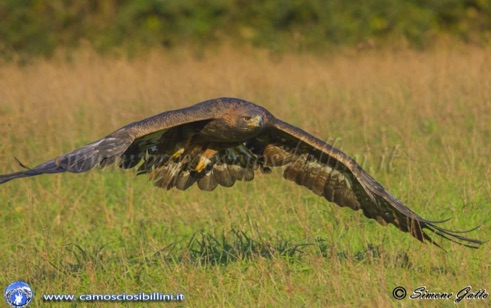
{on the left and upper right, photos of Castelluccio taken by Silvia Serafini; on the lower right, photo of the Royal Eagle of the Sibillini, taken by Simone Gatto, by courtesy of camosciosibillini.it}
The people who lived in these mountains for centuries have created exceptionally high quality food products, some of which are given added recognition by European certification for unique products such as the lentils, ciauscolo – a soft and spreadable salami typical of the area - and the prosciutto from Norcia.
As evidence of the particular ability of creating famous pork products the village of Norcia gave the name 'norcineria' to the traditional preparation of cured meats.
The forests of the park offer truffles all year round, including many varieties both white and black. The woods also abound with chestnuts, which represent a special ingredient in the typical gastronomy of the territory.
Finally, the pastoral tradition of sheep herding has resulted in a distinct breed of sheep called the 'Sopravvissana'. As well as being in important for meat and its particularly dense wool, it provides for the production of the ricotta and the sheep cheese that this area is known for. When this sheep cheese is aged one can virtually taste the richness of the widespread biodiversity characterized within these mountains.
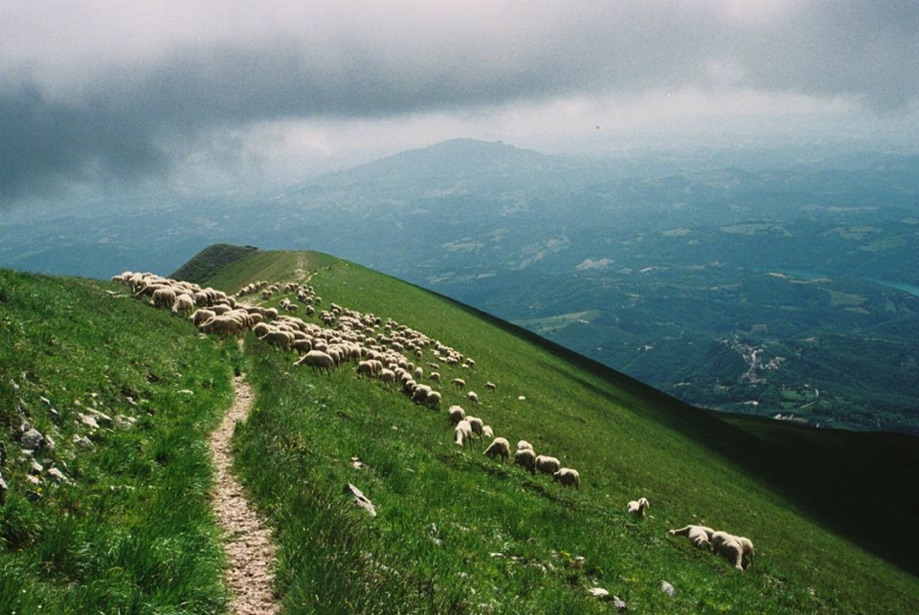
{photo by courtesy of Ella Belfer}

{photo of the Milky Way over Monte Vettore, photo by courtesy of Fabio Pergolesi}
The park offers a discreet and well-organized system of trails for biking, hiking, walking, driving and special historical walking routes. Part of the beauty of the mountains and foothills is the diversity of the landscape and rock formations. From sublime untouched nature, to bucolic postcard type view of olives and Tuscan style villages.
Around the entire park is the Great Circular Route for bikes and hikers which is normally done in nine days with overnight stays the mountain rifugio. A second Great Circular Route exists for cars at a lower level.
Some of the most adventurous and dramatic mountain biking routes in Europe can be found here – there are 14 full day routes as well as the Great Circular Route.
There are 16 Nature routes which offer a taste of the diversity of landscape and flora and fauna, readily available for all and suitable for family outings.
the legend
What follows is a condensed and informed introduction to the myriad of biodiversity, beauty and legends that form the Sibillini Mountains by Dr. M. Talamè, the Officer for Sustainable Tourism and Education for the Sibillini National Park, from her presentation at ExpoMilan (2015):
the landscape & biodiversity
(continued)
the eyes of man
(continued)
the activities
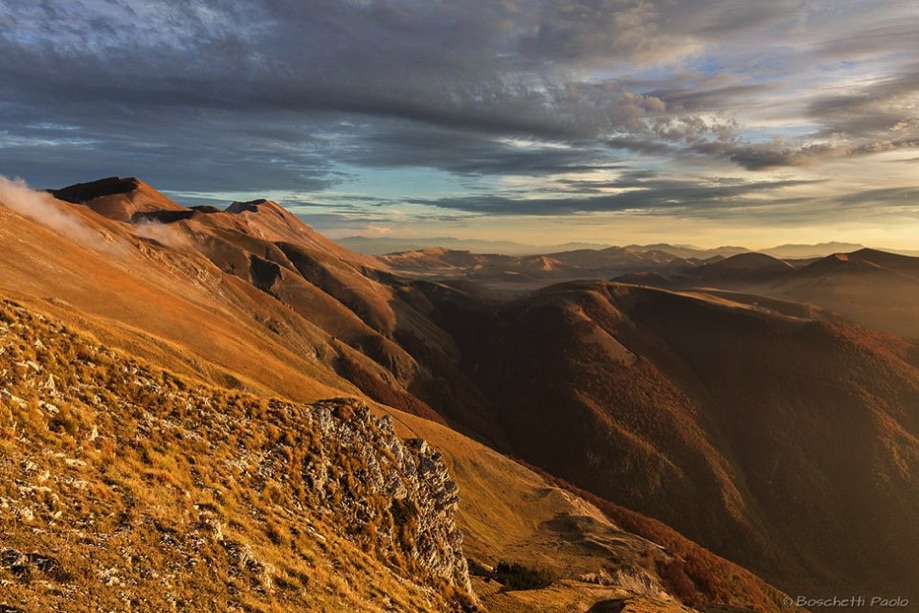
{photo taken by Paolo Boschetti, by courtesy of sibilliniweb.it}
The Sibillini are most famous for the outstanding hiking experiences, which impress even the most intrepid, from the lush and sensual foothills to the challenging high altitude hikes. Again it is the diversity of the landscape and its approachable scale, offering a variety of climatic conditions and flora and fauna. The Park maintains 17 full day hiking routes, yet the mountains are a web of interconnected historic trails. These trails are not maintained but are easily accessed through the local hiking clubs' outings and with guides.
The main hill towns in the Park also have historic walking routes to introduce one to the culture of the settlement. To find out more about the national park, click here.